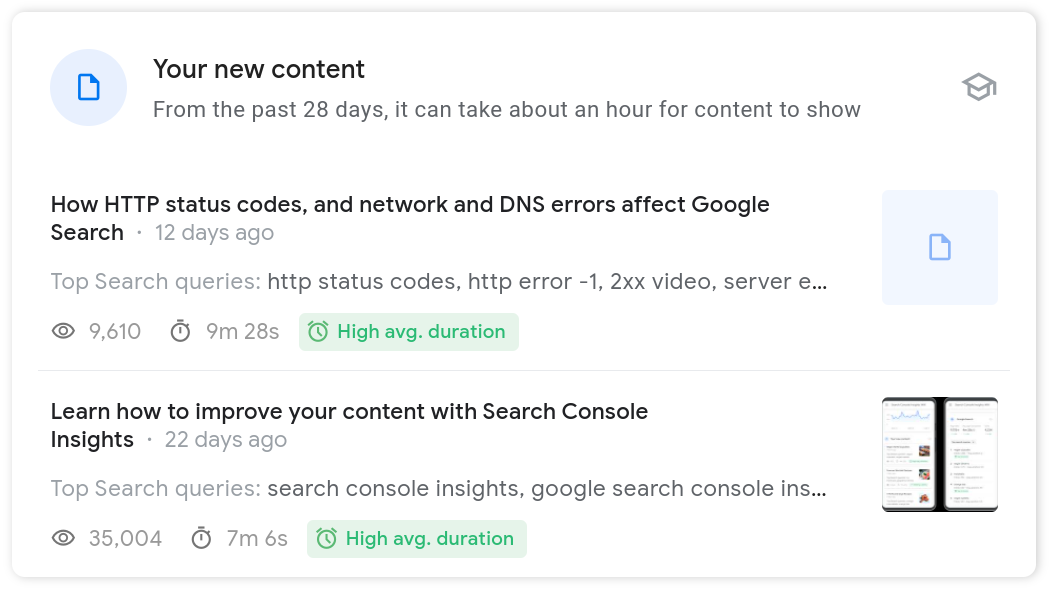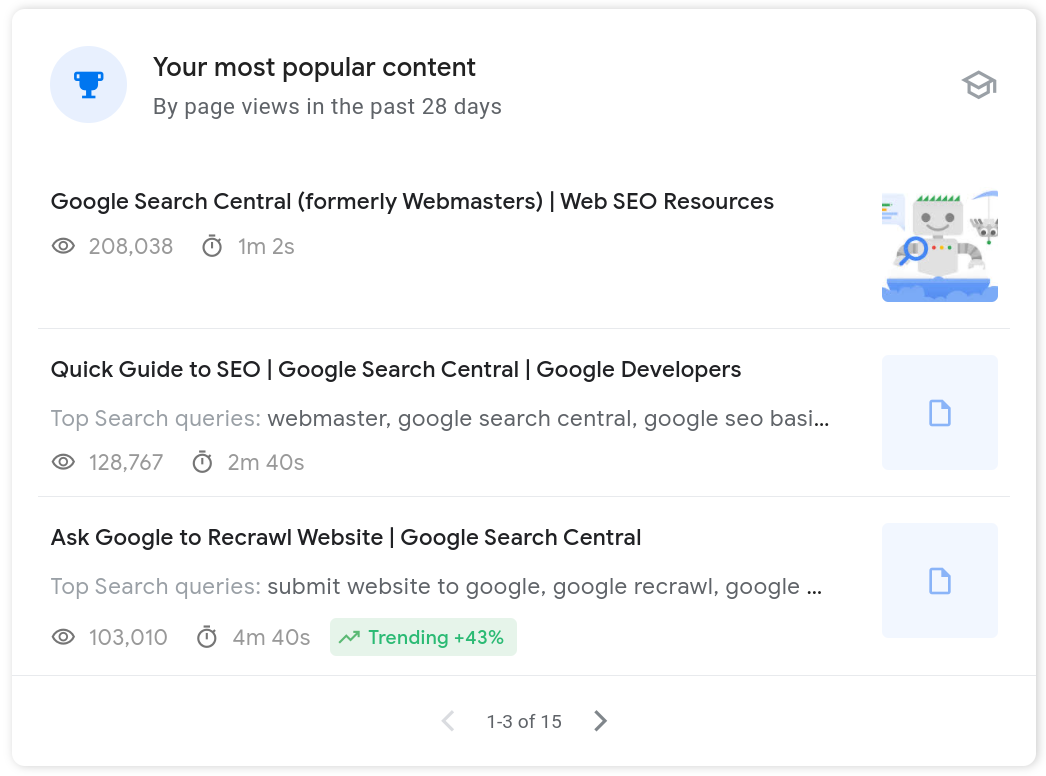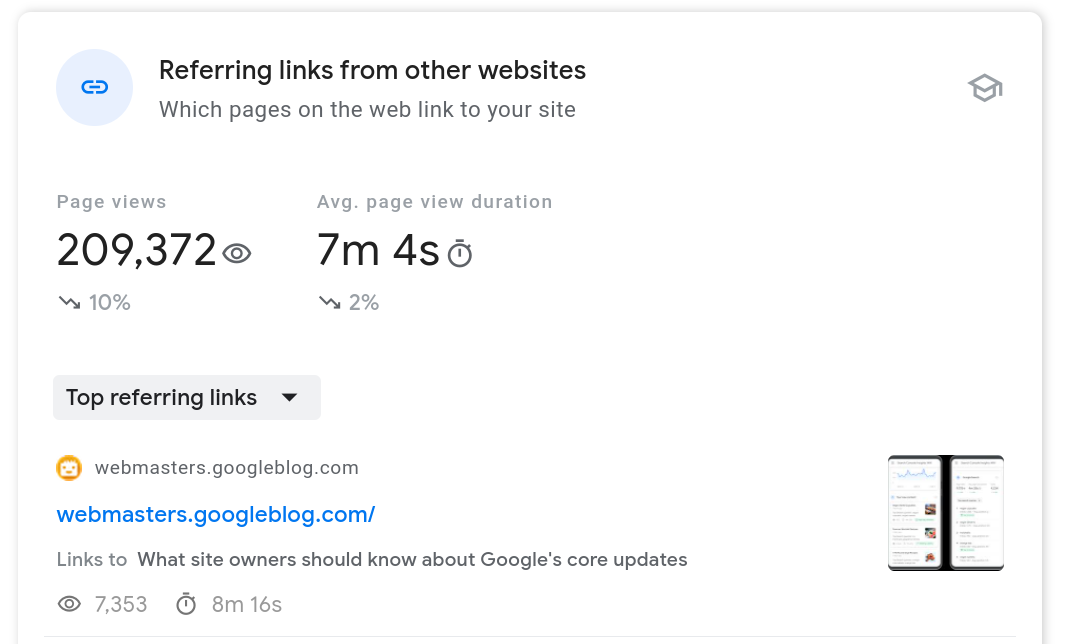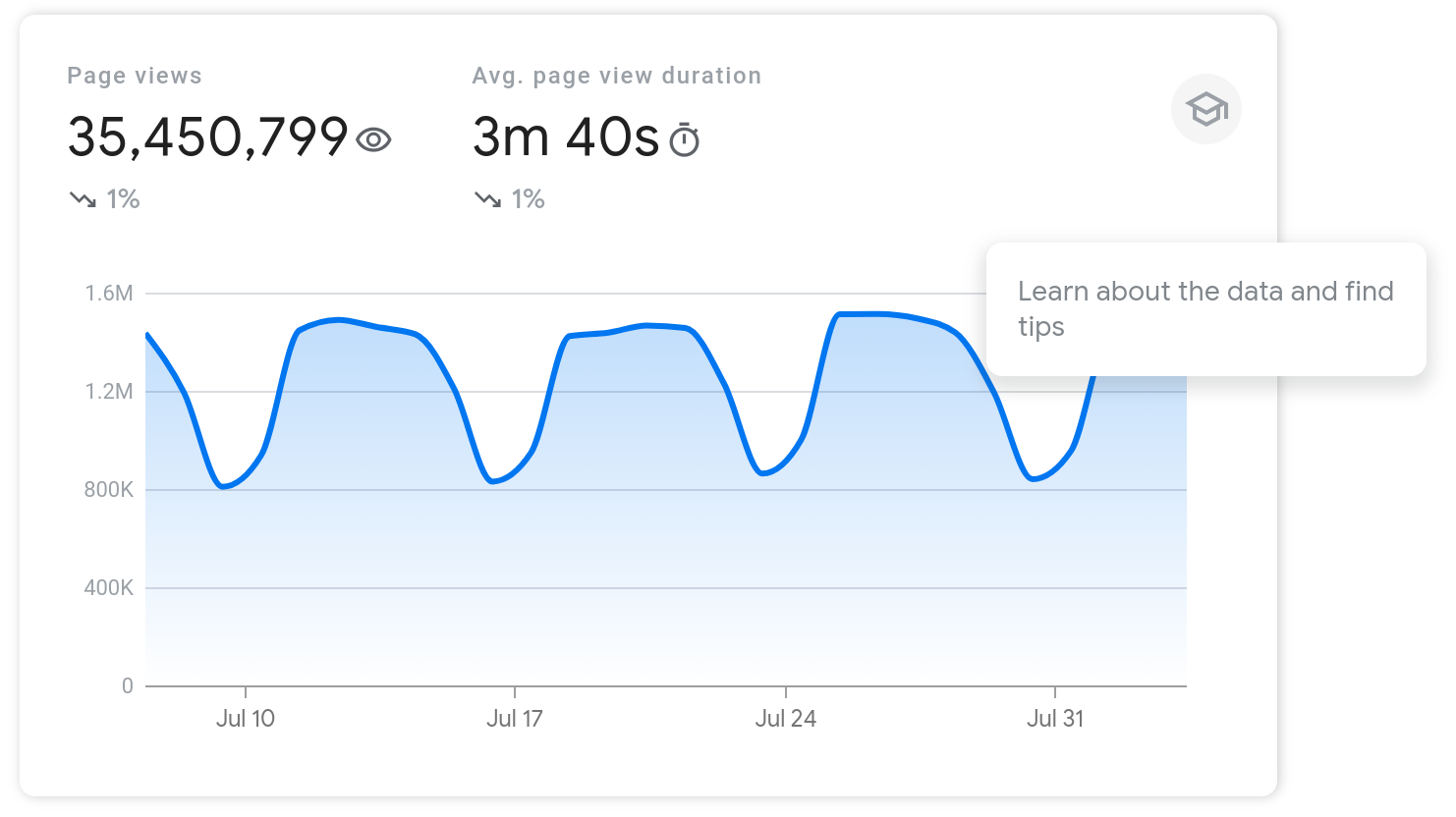2021년 8월 9일 월요일
Search Console 인사이트는 콘텐츠 제작자와 웹사이트 소유자에게 Google Search Console(GSC)과 Google 애널리틱스(GA) 데이터를 모두 맞춤형으로 제공하는 환경입니다. 지난달 발표 후 커뮤니티의 좋은 의견과 데이터에 관한 질문도 받았습니다.
이 게시물에서는 이러한 질문에 답변하고 몇 가지 사항을 명확하게 설명합니다. 예를 들어 GSC 인사이트에 표시되는 데이터를 GA에 표시되는 데이터와 비교하려는 경우 차이가 있을 수 있는데 이유가 무엇인가요?
Google Search Console 인사이트 자주 묻는 질문(FAQ)
Search Console 인사이트에서 Google 애널리틱스 데이터를 볼 수 없는 이유는 무엇인가요?
GA를 Search Console에 올바르게 연결하면 콘텐츠 실적을 파악할 수 있는 유용한 정보를 더 많이 볼 수 있습니다. 연결하지 않으면 Google 검색 카드만 볼 수 있습니다.
GA 데이터가 GSC 인사이트에 표시되지 않는 데는 몇 가지 이유가 있습니다.
- GSC 속성이 GA 속성과 연결되어 있지 않습니다. 고객센터를 방문하여 연결하는 방법을 알아보세요. 특히 GSC에서 별도의 HTTP와 HTTPS 트래픽 속성이 있다면 가장 많은 트래픽이 발생하는 속성을 연결하거나 모든 트래픽을 한 곳에 포함하도록 도메인 속성을 확인하는 것이 좋습니다. 현재 Google 애널리틱스 4 속성은 연결할 수 없지만 Google에서는 문제 해결을 위해 노력하고 있습니다.
- GA에 관한 권한이 충분하지 않습니다. GSC 속성이 GA 속성과 연결되어 있지만 GA 데이터가 계속 표시되지 않으면 연결된 GA 속성 읽기 및 분석 권한이 있는지 확인합니다.
- GSC에서 잘못된 GA 뷰를 선택했습니다. GSC 인사이트는 연결된 속성에서 특정 GA 뷰의 GA 데이터를 가져옵니다. 속성 아래에 뷰가 없으면 데이터를 채울 수 없습니다. Search Console 연결 페이지에서 선택된 뷰를 확인하거나 변경할 수 있습니다.
Google 애널리틱스에 표시되는 데이터가 Search Console 인사이트와 다른 이유는 무엇인가요?
먼저 이 고객센터 도움말에 설명된 대로 GA 데이터와 GSC 데이터가 여러 면에서 다르다는 점을 이해하는 것이 중요합니다. 데이터는 정의상으로 다릅니다. 하나는 Google 검색에서 발생한 활동을 의미하고 다른 하나는 사이트에서의 사용자 행동을 의미하기 때문입니다. 또한 다음은 구체적으로 살펴볼 몇 가지 사항입니다.
- 페이지 제목과 URL: GSC의 다른 보고서는 URL에 기반하지만 GSC 인사이트는 GA의 페이지 제목 측정기준을 사용합니다. 각 페이지 제목에는 URL이 여러 개 있을 수 있습니다. GSC 인사이트는 가장 눈에 띄는 표준 URL을 추출하여 Google 검색 데이터를 가져옵니다.
- 기간: GSC 인사이트는 지난 28일간의 GA 데이터를 보여주는데(마지막 날은 부분 데이터를 사용할 수 있음) 이전 28일과 비교하여 보여주는 때도 있습니다. GA와 GSC의 기본 기간이 다르므로 둘을 비교할 때 날짜가 같은지 확인해야 합니다. GA에서는 시간대를 설정할 수 있지만 GSC 인사이트는 항상 태평양 일광절약 시간을 사용하므로 특정 날짜라도 비교 시 다를 수 있습니다.
- 측정항목: GSC 인사이트는 GA 측정항목(페이지 조회수, 페이지에 머문 평균 시간)과 Google 검색 측정항목(클릭수, 평균 게재순위)을 결합합니다. 이러한 측정항목은 사이트의 다양한 측면을 나타내며 다르게 계산됩니다.
Search Console 인사이트는 '새 콘텐츠'를 어떻게 선택하나요?

새 콘텐츠 카드에는 지난 28일 동안 첫 페이지 조회가 발생한 사이트의 페이지가 표시됩니다. 각 제목의 경우 주요 표준 URL의 인기 검색어도 표시될 수 있습니다. 콘텐츠는 최신순으로 정렬되며 조회수가 어느 정도 있어야 표시됩니다. 이 카드를 채우는 데 Google에서 사용하는 주요 정보는 3가지입니다.
- 먼저 지난 28일 동안 트래픽이 발생했지만 그전 1년 동안 트래픽이 발생하지 않은 페이지 제목을 확인합니다.
- 여러 규칙을 적용하여 데이터를 정리하고 새 콘텐츠가 될 가능성이 낮은 페이지를 필터링합니다. 제목 변경, 댓글 페이지, 내부 검색결과 페이지 등을 예로 들 수 있습니다.
- 같은 콘텐츠의 번역본을 필터링하고 실적이 가장 우수한 제목을 유지합니다. GA 인터페이스의 측정항목과 혼동을 피하기 위해 번역된 페이지의 측정항목을 집계하지 않습니다.
Google에서 새 콘텐츠를 보고하지 않았다고 해서 GA 트래픽이 없거나 색인이 생성되지 않은 것은 아닙니다. GSC 인사이트는 GA에서 데이터를 가져올 때 색인이 생성되지 않은 콘텐츠를 표시할 수 있습니다. 새 콘텐츠는 첫 번째 크롤링 시간에 의존하지 않으므로 콘텐츠를 크롤링하거나 색인을 생성해야 이 카드에 표시되는 것은 아닙니다.
Search Console 인사이트는 '가장 인기 있는 콘텐츠'를 어떻게 선택하나요?

가장 인기 있는 콘텐츠 카드는 지난 28일 동안 페이지 조회수별로 실적이 가장 우수한 페이지 제목을 보여줍니다. 각 제목의 경우 주요 표준 URL의 인기 검색어도 표시될 수 있습니다. 이 콘텐츠의 자세한 Google 검색 데이터를 확인하려면 콘텐츠를 클릭하고 페이지 개요로 드릴다운하면 됩니다.
URL이 연결된 GSC 속성 아래에 없으면 Google 검색 데이터를 가져올 수 없습니다.
Search Console 인사이트는 다른 웹사이트의 참조된 링크를 어떻게 선택하나요?

다른 웹사이트의 참조된 링크 카드는 사용자가 다른 사이트에서 내 콘텐츠로 연결되는 링크를 통해 내 사이트의 콘텐츠를 발견하는 방식을 보여줍니다.
이 보고서의 목표는 특정 참조 페이지로 생성된 방문 수에 관한 프록시를 제공하는 것입니다. GA에서는 특정 추천의 트래픽을 보면 현재 세션의 모든 페이지 조회수가 포함됩니다. GSC 인사이트에서는 특정 추천의 각 수신 세션의 경우 페이지 조회수 1회만 계산됩니다. 이 카드에 표시되는 트래픽은 GA에서 익숙하게 본 추천 트래픽의 일부일 뿐입니다.
Google에서는 상위 트래픽 채널 카드에 이 로직을 사용하지 않습니다. 페이지 조회수는 일반적으로 추천 채널과 비교할 때 참조된 링크 카드에서 더 낮습니다.
Google 검색 카드에서 클릭수가 페이지 조회수보다 낮은 이유는 무엇인가요?
클릭수가 페이지 조회수보다 낮은 세 가지 주요 이유는 다음과 같습니다.
- 각 클릭은 1회 이상의 페이지 조회를 유발할 수 있습니다. 세션 중에 발생한 다른 페이지 조회수도 Google / 자연으로 간주됩니다. 세션 정의 및 분류 방식 자세히 알아보기
- Google / 자연의 GA 페이지 조회수에는 디스커버, 이미지 검색, 동영상 검색과 같은 웹 검색결과보다 노출 영역이 더 많이 포함됩니다.
- GA와 GSC가 반드시 같은 페이지 그룹에 관해 보고하는 것은 아닙니다. 예를 들어 HTTP 페이지만 포함된 GSC 계정이 있지만 선택한 GA 뷰는 HTTP와 HTTPS에 관해 모두 보고할 수 있습니다.
GSC 인사이트 카드의 다양한 배지는 무엇을 의미하나요?
GSC 인사이트에 도입된 배지를 통해 데이터의 흥미로운 패턴에 집중할 수 있습니다. 현재 배지는 세 가지가 있습니다.
- 높은 평균 조회 시간: 사이트의 다른 콘텐츠에 비해 콘텐츠의 평균 조회 시간이 높습니다. 사용자의 흥미를 유도한 콘텐츠일 수 있습니다.
- 상위 5개 검색결과: 지난 28일 동안 주어진 검색어에 관한 콘텐츠의 Google 검색(자연) 평균 게재순위가 5위 안에 듭니다.
- 트렌드 x%: 지난 28일과 이전 실적 간의 비교를 나타냅니다. 이 배지는 트렌드가 일반 사이트 트렌드보다 훨씬 높은 경우에만 표시됩니다.
데이터 알아보기, 도움말과 추가 리소스 찾기
GSC 인사이트에서 제공되는 각 카드에 관한 자세한 내용은 아래 스크린샷에 나온 것처럼 작은 모자를 클릭하세요. 그러면 데이터에 관한 자세한 내용과 해석 방법에 관한 도움말을 확인할 수 있습니다. 예를 들어 차트 변경의 의미와 차트와 표에 사용되는 측정항목의 정의에 관한 간략한 설명이 있습니다.

질문이나 의견이 있다면 GSC 인사이트에서 제공되는 의견 보내기 버튼을 클릭하거나 Twitter를 통해 문의하거나 Google 검색 센터 커뮤니티에 질문을 올려주세요.
